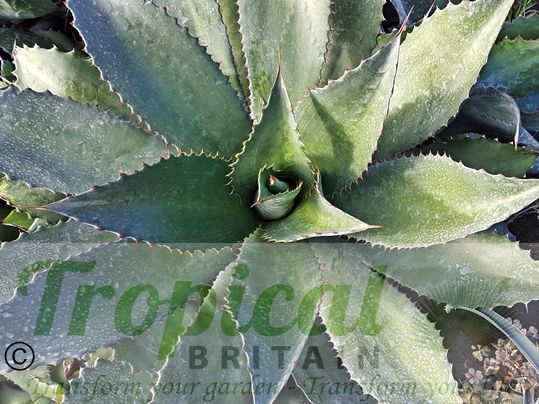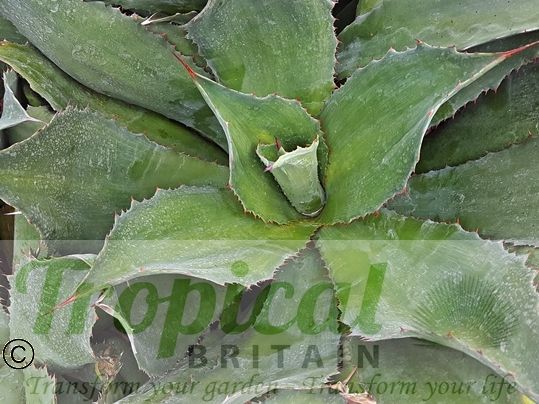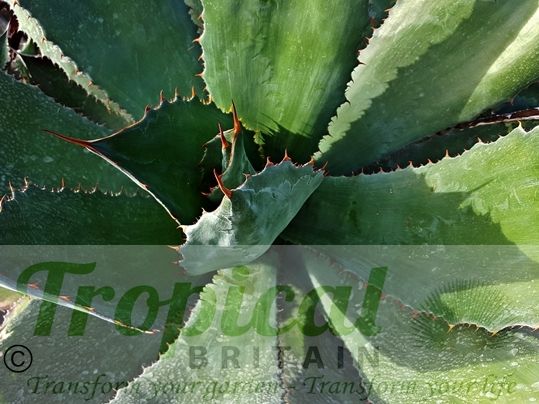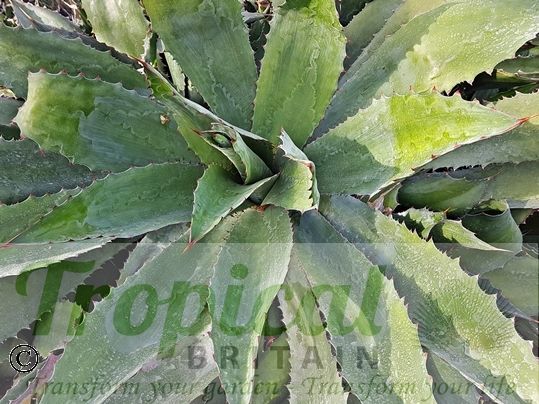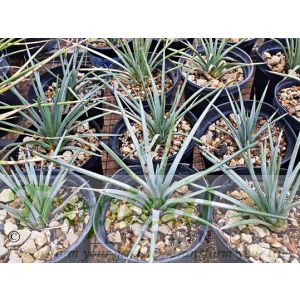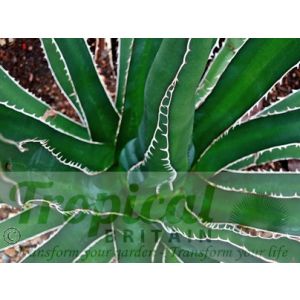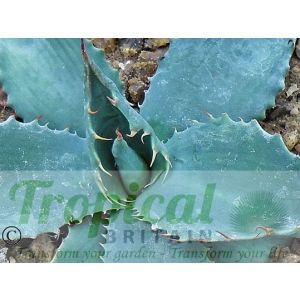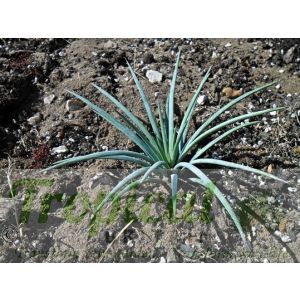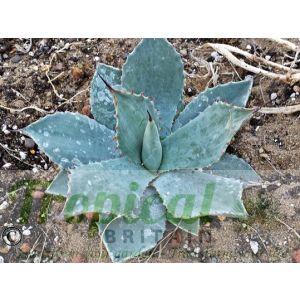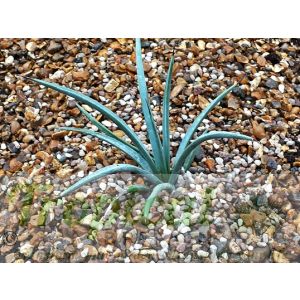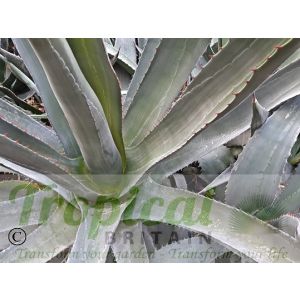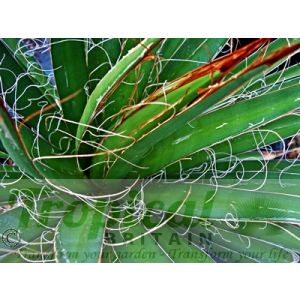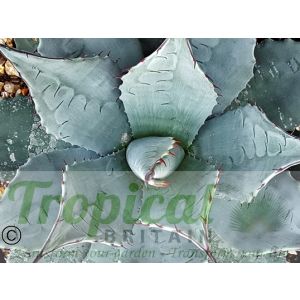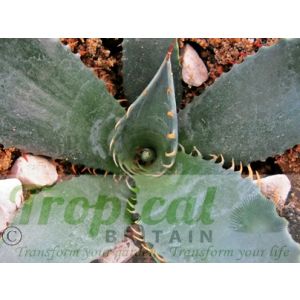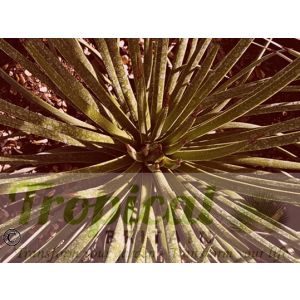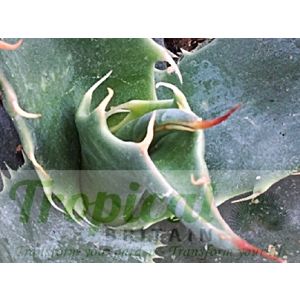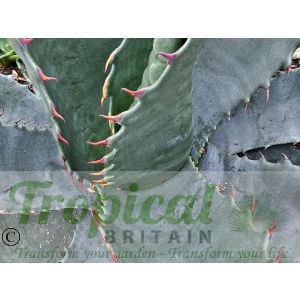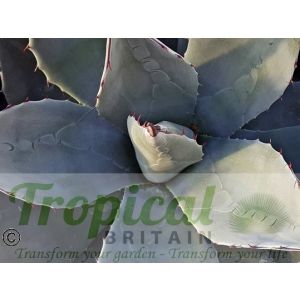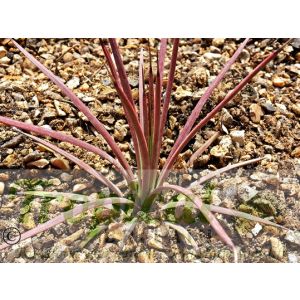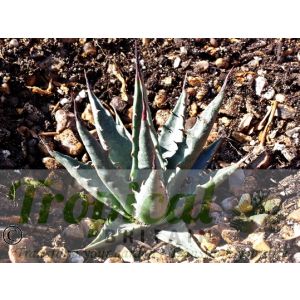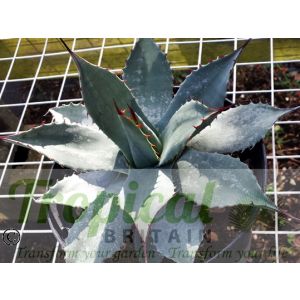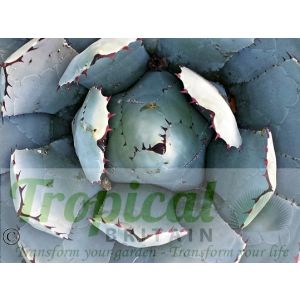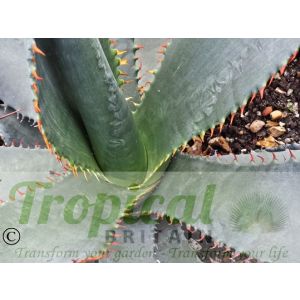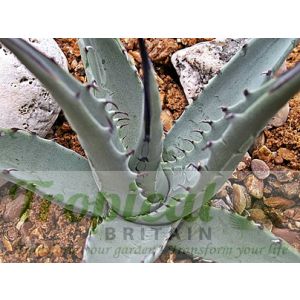- Fast growing Agave
- Under threat in the wild
- Huge inflorescence when mature
- Drought resistant
Agave cupreata, the Dwarf Cowhorn Agave, first described by William Trelease and Alwin Berger in 1915, is endemic to the cooler forested mountain slopes of the Rio Balsas Depression - the hottest driest region in all of Mexico - in the states of Guerrero and Michoacán in Southwestern México, where it grows in mixed forests of deciduous oaks, lindens, and pines up to elevations of 2000 metres. A highly attractive species, Agave cupreata is a small to medium-sized Agave with broad, glaucous-green, obovate leaves edged with copper-coloured spines along wavy margins. It does not form offsets and we have found it to be a very fast-growing species as if all its energy is focused on producing its 'calehaul', the flowering spike of yellow funnel-shaped flowers that is pollinated by bats in its native range. Perhaps this is just as well, for in the wild its populations have been decimated over the last twenty-five years by the harvesting of mature specimens, cut just before their monocarpic flowering cycle for the production of mezcal.
Mezcal, unlike Tequila which can only be made from Agave tequilana, is traditionally made from a number of different Agaves usually collected from the wild and known as Maguey. In Guerrero and Michoacán the Agave used is Agave cupreata.
Mezcal and Tequila are both made by roasting agave hearts or 'pinas' in an oven. These leaf bases become enriched with sugars prior to flowering and the emerging flower stalk is cut to concentrate the sugars in the 'pina' which is then harvested and fermented. Thus, our unfortunate Agave cupreata, unable to set seed and incapable of reproducing by offsets, is distinctly vulnerable and numbers have declined significantly. This decline has been exacerbated by cattle which graze in the forested uplands and which trample the smaller plants and seedlings underfoot.
The entire situation has escalated since the mid-1980's when the soaring popularity of Tequila and the declining availability of Agave tequilana in large enough numbers to sustain commercial plantations and keep the liquor flowing, instigated the Mexican government to legalise the production of artisanal mezcal made from wild-harvested Agave.
The mescaleros in the Chilapa region have now begun to leave some larger plants to flower and are scattering collected seed throughout the harvest area and protecting some areas from encroachment by cattle. Areas have been set aside where the gathering of native flora is banned. They have also set up community nurseries both for Agave cupreata and for the firewood species necessary to smoke the 'pinas'. In neighbouring Michoacán, commercial plantation areas have been established with the realisation that harvesting wild populations simply isn't sustainable.
Nontheless, it is clear that unless further designated areas are set aside, not as commercial resources, but as forest conservation units so that the natural populations of Agave cupreata can establish as a genetic resource, the future for this species in the wild looks bleak.
In cultivation in the UK, we have found Agave cupreata to be tender and we take the precaution in winter to keep it completely dry under glass and protected with several layers of fleece. Its relatively small-to-medium habit also makes it ideal as a container plant that can be bought undercover from October through to Spring. With its fast growth-rate, its highly desirable foliage and threatened status, Agave cupreata is an attractive Agave that should be more widely grown.
These 2L plants are enormous! and heavy!
Additional Information
| Order | Asparagales |
|---|---|
| Family | Asparagaceae |
| Sub-Family | Agavoideae |
| Geographical Origin | Southwest Mexico: Guerrero and Michoacán states |
| Cultivation | Full sun, dry. Free-draining substrate. Keep totally dry in winter |
| Eventual Height | 0.8m - inflorescence to 7m |
| Eventual Spread | 1m |
| Hardiness | Tender, usually needing some protection in a typical UK winter. Best indoors. Keep it dry and under several layers of fleece |

Free DELIVERY
ON ALL ORDERS OVER £99THIS OFFER IS VALID ON ALL OUR STORE ITEMS.
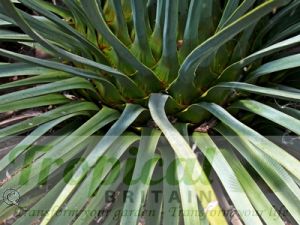

THE PLANTS
- Smaller-Growing Succulents
- Aeonium
- Agave
- Agave americana
- Agave amica
- Agave chrysantha
- Agave cupreata
- Agave deserti
- Agave filifera
- Agave gentryi
- Agave gomezpompae
- Agave havardiana
- Agave horrida ssp horrida
- Agave lechuguilla
- Agave mitis var mitis
- Agave montana
- Agave palmeri
- Agave parryi
- Agave polianthiflora
- Agave striata
- Agave stricta Rubra
- Agave toumeyana
- Agave univittata
- Agave utahensis
- Agave victoriae-reginae - Huasteca Canyon
- Aloe
- Beschorneria
- Bryophyllum
- Dasylirion
- Furcraea
- Hesperaloe
- Hesperoyucca
- Nolina
- Yucca
- Astrophytum
- Austrocylindropuntia
- Brasiliopuntia brasiliensis
- Cereus
- Chamaecereus silvestrii
- Cleistocactus
- Cumulopuntia
- Cylindropuntia
- Echinocereus
- Echinopsis
- Epiphyllum
- Ferocactus
- Gymnocalycium
- Hatiora
- Kroenleinia grusonii
- Lophocereus
- Maihuenia
- Mammillaria
- Matucana
- Myrtillocactus geometrizans
- Opuntia
- Opuntia arenaria SB964
- Opuntia atrispina
- Opuntia basilaris
- Opuntia chisosensis SB992 Brewster Co, TX
- Opuntia cymochila - Brewster Co, TX
- Opuntia engelmannii var. sandia
- Opuntia erinacea
- Opuntia fragilis
- Opuntia humifusa
- Opuntia lindheimeri - Beeville, TX
- Opuntia phaeacantha
- Opuntia pottsii var. nova DJF1441 SW Albuquerque, NM
- Opuntia robusta
- Opuntia sandiana
- Opuntia sanguinicola
- Opuntia stricta
- Opuntia strigil
- Opuntia trichophora
- Oroya peruviana
- Parodia
- Polaskia
- Rhipsalis
- Schlumbergera
- Stenocactus
- Stetsonia
- Tephrocactus
- Alocasia
- Amorphophallus
- Arisaema
- Arum
- Calla
- Caladium
- Colocasia
- Dracunculus
- Monstera
- Helicodiceros muscivorus
- Philodendron
- Pinellia
- Remusatia
- Sauromatum
- Spathantheum
- Typhonium
- Xanthosoma
- Zantedeschia

